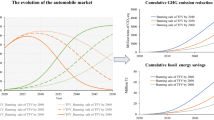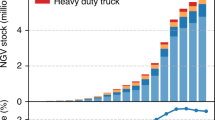Abstract
China is responsible for around one-quarter of global vehicle production. The associated Greenhouse Gas (GHG) emissions have become a major concern to the industrial sustainable development. With the aim of identifying the opportunities of cutting GHG emissions from China’s automotive industry, this study estimates the life cycle GHG emissions from vehicle production in China and compares the results with the case in the USA from multiple perspectives. The results reveal that the GHG emissions from the production of a standard internal combustion engine-based passenger vehicle in China are around 9.6 ton per vehicle, 54% higher than the US level of 6.2 ton per vehicle. The power-intensive nature of vehicle production and China’s higher GHG emission intensity of power generation are the major reasons behind the difference. Accordingly, total GHG emissions from passenger vehicle production in China were around 173.9 million tons in 2013, accounting for nearly 3% of the GHG emissions from the manufacturing and construction sector. Based on the analysis, it is recommended that China should further optimize the grid mix and reduce the emission intensity of power generation. Besides, emission intensities of steel and aluminum productions should be further reduced through applying energy-efficient technologies and promoting material recycling.






Similar content being viewed by others
Abbreviations
- BF:
-
Blast furnace
- BFG:
-
Blast furnace gas
- BOF:
-
Basic oxygen furnace
- CAAM:
-
China Association of Automobile Manufacturers
- CCP:
-
Consumable components production
- COG:
-
Coke oven gas
- EAF:
-
Electric arc furnace
- EV:
-
Electric vehicle
- FCV:
-
Fuel cell vehicle
- GHG:
-
Greenhouse Gas
- HEV:
-
Hybrid electric vehicle
- HVAC:
-
Heating, ventilating and air conditioning
- ICE:
-
Internal combustion engine
- ICEV:
-
Internal combustion engine vehicle
- IEA:
-
International energy agency
- INDCs:
-
Intended nationally determined contributions
- IPCC:
-
Intergovernmental panel on climate change
- LCA:
-
Life cycle assessment
- NBSC:
-
National Bureau of Statistics of China
- NDRC:
-
National Development and Reform Commission
- OCP:
-
Original components production
- OICA:
-
Organisation Internationale des Constructeurs d’Automobiles
- PHEV:
-
Plug-in hybrid electric vehicle
- WTW:
-
Well-to-Wheel
References
Argonne National Laboratory (ANL) (2015) The Greenhouse Gases, regulated emissions, and energy use in transportation model. Chicago University, U.S. greet.es.anl.gov. Accessed March 2016
Bauer C, Hofer J, Althaus HJ, Duce AD, Simons A (2015) The environmental performance of current and future passenger vehicles: life cycle assessment based on a novel scenario analysis framework. Appl Energy 157:871–883
Burnham A (2012) Updated vehicle specifications in the GREET vehicle-cycle model. Chicago University, U.S. greet.es.anl.gov/publication-update-veh-specs. Accessed March 2016
Chen YS (2014) A study on life cycle ecological benefits assessment of automotive parts (unpublished publicly). Ph.D. Academic Dissertation, Hunan University, China, pp 42–48
China Association of Automobile Manufacturers (CAAM) (2016) China Automotive Industry Yearbook 2000–2015. Bei**g, China
Chinese Government (2015) Enhanced actions on climate change: China’s intended nationally determined contributions. Bei**g, China. www.sdpc.gov.cn/xwzx/xwfb/201506/t20150630_710204.html. Accessed March 2016
Chinese State Council (2012) Planning for the development of the energy-saving and new energy automobile industry (2012–2020). Bei**g, China. www.gov.cn/zwgk/2012-07/09/content_2179032.htm. Accessed September 2016
Das S (2000) The life-cycle impacts of aluminum body-in-white automotive material. J Miner Metals Mater Soc 52(8):41–44
Das S (2004) A comparative assessment of alternative powertrains and body-in-white materials for advanced technology vehicles. SAE Technical Paper. 01-0573
Dhingra R, Das S (2014) Life cycle energy and environmental evaluation of downsized vs. lightweight material automotive engines. J Clean Prod 85:347–358
Editorial Board of China Steel Yearbook (2015) China steel yearbook 2015. Metallurgical Industry Press, Bei**g
Greenhouse Gas Protocol (2015) What is the difference between direct and indirect emissions. Washington DC, U.S. www.ghgprotocol.org/calculation-tools/faq. Accessed March 2016
Hao H, Wang H, Yi R (2011a) Hybrid modeling of China’s vehicle ownership and projection through 2050. Energy 36:1351–1361
Hao H, Wang H, Ouyang M (2011b) Fuel conservation and GHG (Greenhouse gas) emissions mitigation scenarios for China’s passenger vehicle fleet. Energy 36(11):6520–6528
Hao H, Geng Y, Wang H, Ouyang M (2014) Regional disparity of urban passenger transport associated GHG emissions in China: a review. Energy 69:783–793
Hao H, Geng Y, Hang W (2016a) GHG emissions from primary aluminum production in China: regional disparity and policy implications. Appl Energy 166:264–272
Hao H, Geng Y, Sarkis J (2016b) Carbon footprint of global passenger cars: scenarios through 2050. Energy 101:121–131
Hawkins TR, Singh B, Majeau-Bettez G, Strømman AH (2013) Comparative environmental life cycle assessment of conventional and electric vehicles. J Ind Ecol 17(1):53–64
Howell S, Lee H, Heal A (2014) Leapfrogging or stalling out? Electric vehicles in China. HKS Working Paper No. RWP14-035. Harvard University, U.S. ssrn.com/abstract=2493131. Accessed March 2016
Intergovernmental Panel on Climate Change (IPCC) (2006) 2006 IPCC Guidelines for National Greenhouse Gas Inventories. Institute for Global Environmental Strategies, Hayama, Japan. www.ipcc-nggip.iges.or.jp/public/2006gl. Accessed March 2016
Internation Energy Agency (IEA) (2015) CO2 emissions from fuel combustion. Paris, France. www.iea.org/statistics/relateddatabases/co2emissionsfromfuelcombustion/. Accessed March 2016
**g R, Cheng JCP, Gan VJL, Woon KS, Lo IMC (2014) Comparison of greenhouse gas emission accounting methods for steel production in China. J Clean Prod 83:165–172
Kim HJ, McMillan C, Keoleian GA, Skerlos SJ (2010) Greenhouse gas emissions payback for lightweighted vehicles using aluminum and high-strength steel. J Ind Ecol 14(6):929–946
Lewis AM, Kelly JC, Keoleian GA (2014) Vehicle lightweighting vs. electrification: life cycle energy and GHG emissions results for diverse powertrain vehicles. Appl Energy 126:13–20
Li Y, Zhu L (2014) Cost of energy saving and CO2 emissions reduction in China’s iron and steel sector. Appl Energy 130:603–616
Lin B, Omoju OE, Okonkwo JU (2016) Factors influencing renewable electricity consumption in China. Renew Sustain Energy Rev 55:687–696
Ma C, Li S, Ge Q (2014) Greenhouse gas emission factors for grid electricity for Chinese provinces. Resour Sci 36(5):1005–1012
Mahdizadeh KM, Gholami SMA, Valipour M (2015) Simulation of open-and closed-end border irrigation systems using SIRMOD. Arch Agron Soil Sci 61(7):929–941
McKenzie EC, Durango-Cohen PL (2012) Environmental life-cycle assessment of transit buses with alternative fuel technology. Transp Res Part D Transp Environ 17(1):39–47
Nanaki EA, Koroneos CJ (2013) Comparative economic and environmental analysis of conventional, hybrid and electric vehicles—the case study of Greece. J Clean Prod 53:261–266
National Bureau of Statistics of China (NBSC) (2016) Annual provincial power generation. Bei**g, China. data.stats.gov.cn/easyquery.htm?cn=C01. Accessed May 2016
National Development and Reform Commission (NDRC) (2014) Chinese low carbon development and training materials of listing of provincial greenhouse gas. Bei**g, China. qhs.ndrc.gov.cn/gzdt/201403/t20140328_604827.html. Accessed March 2016
National Development and Reform Commission (NDRC) (2015) 2014 Chinese Regional power grid baseline emission factor. Bei**g, China. cdm.ccchina.gov.cn/zyDetail.aspx?newsId=52507&TId = 160. Accessed March 2016
Organisation Internationale des Constructeurs d’Automobiles (OICA) (2016) Global vehicle production. Paris, France. www.oica.net/. Accessed March 2016
Orsi F, Muratori M, Rocco M, Colombo E, Rizzoni G (2016) A multi-dimensional well-to-wheels analysis of passenger vehicles in different regions: primary energy consumption, CO2 emissions, and economic cost. Appl Energy 169:197–209
Serrenho AC, Mourão ZS, Norman J, Cullen JM, Allwood JM (2016) The influence of UK emissions reduction targets on the emissions of the global steel industry. Resour Conserv Recycl 107:174–184
Sullivan JL, Burnham A, Wang M (2010) Energy-consumption and carbon-emission analysis of vehicle and component manufacturing. Argonne National Laboratory (ANL)
Sullivan JL, Burnham A, Wang M (2013) Model for the part manufacturing and vehicle assembly component of the vehicle life cycle inventory. J Ind Ecol 17(1):143–153
Valipour M (2012a) Sprinkle and trickle irrigation system design using tapered pipes for pressure loss adjusting. J Agric Sci 4(12):125
Valipour M (2012b) Comparison of surface irrigation simulation models: full hydrodynamic, zero inertia, kinematic wave. J Agric Sci 4(12):68
Valipour M (2016) Optimization of neural networks for precipitation analysis in a humid region to detect drought and wet year alarms. Meteorol Appl 23(1):91–100
Valipour M, Sefidkouhi MAG, Eslamian S (2015) Surface irrigation simulation models: a review. Int J Hydrol Sci Technol 5(1):51–70
Wang K, Wang C, Lu X, Chen J (2007) Scenario analysis on CO2 emissions reduction potential in China’s iron and steel industry. Energy Policy 35(4):2320–2335
Wang D, Zamel N, Jiao K, Zhou Y, Yu S, Du Q (2013) Life cycle analysis of internal combustion engine, electric and fuel cell vehicles for China. Energy 59:402–412
Weng XH (2009) Research about the problems exist in the statistics of comprehensive energy consumption per unit product of coke in China. Metall Econ Manag 2009(4):22–26
Wübbeke J, Heroth T (2014) Challenges and political solutions for steel recycling in China. Resour Conserv Recycl 87:1–7
**a X, Li J, Tian H, Zhou Z, Li H, Tian G (2016) The construction and cost-benefit analysis of end-of-life vehicle disassembly plant: a typical case in China. Clean Technol Environ Policy. doi:10.1007/s10098-016-1185-0
Yang N, Huang Q, He L, You X, Wu L (2010) Domestic and international status and development trend of steelmaking compact process. China Metall 4:005
Yang D, **gru L, Jianxin Y, Ding N (2014) Carbon footprint analysis of radial tyres of passenger cars. Chin J Popul Resour Environ 24:110–114
Yannopoulos SI, Lyberatos G, Theodossiou N, Li W, Valipour M, Tamburrino A (2015) Evolution of water lifting devices (pumps) over the centuries worldwide. Water 7(9):5031–5060
Zamel N, Li X (2006) Life cycle analysis of vehicles powered by a fuel cell and by internal combustion engine for Canada. J Power Sour 155(2):297–310
Zhao F, Hao H, Liu Z (2016) Technology strategy to meet China’s 5 L/100 km fuel consumption target for passenger vehicles in 2020. Clean Technol Environ Policy 18(1):7–15
Acknowledgements
This study is sponsored by the National Natural Science Foundation of China (71403142, 71690241, 71572093), Bei**g Natural Science Foundation (9162008), State Key Laboratory of Automotive Safety and Energy (ZZ2016-024). The authors would like to thank the anonymous reviewers for their reviews and comments.
Author information
Authors and Affiliations
Corresponding author
Appendix: Vehicle specification
Appendix: Vehicle specification
See Table 5.
Rights and permissions
About this article
Cite this article
Hao, H., Qiao, Q., Liu, Z. et al. Comparing the life cycle Greenhouse Gas emissions from vehicle production in China and the USA: implications for targeting the reduction opportunities. Clean Techn Environ Policy 19, 1509–1522 (2017). https://doi.org/10.1007/s10098-016-1325-6
Received:
Accepted:
Published:
Issue Date:
DOI: https://doi.org/10.1007/s10098-016-1325-6




